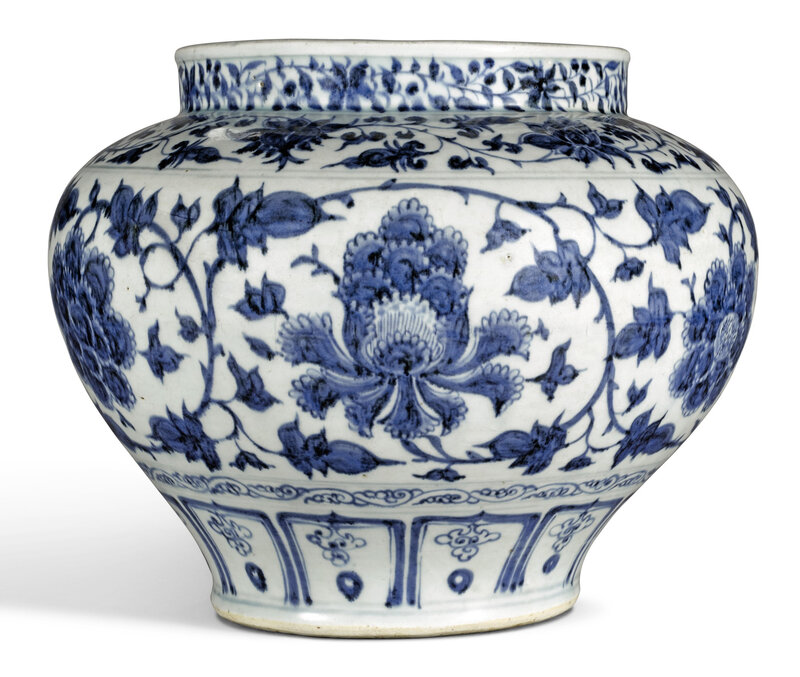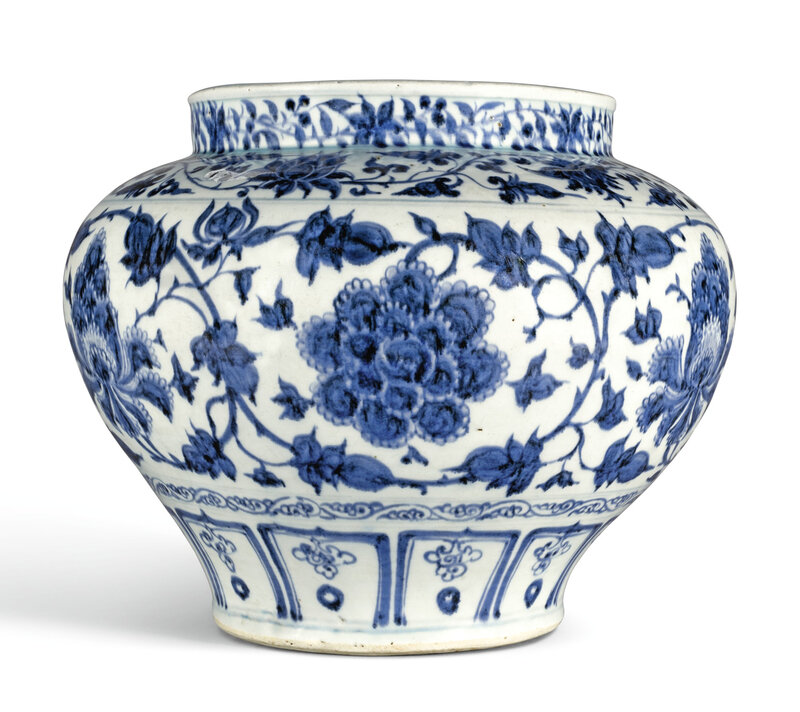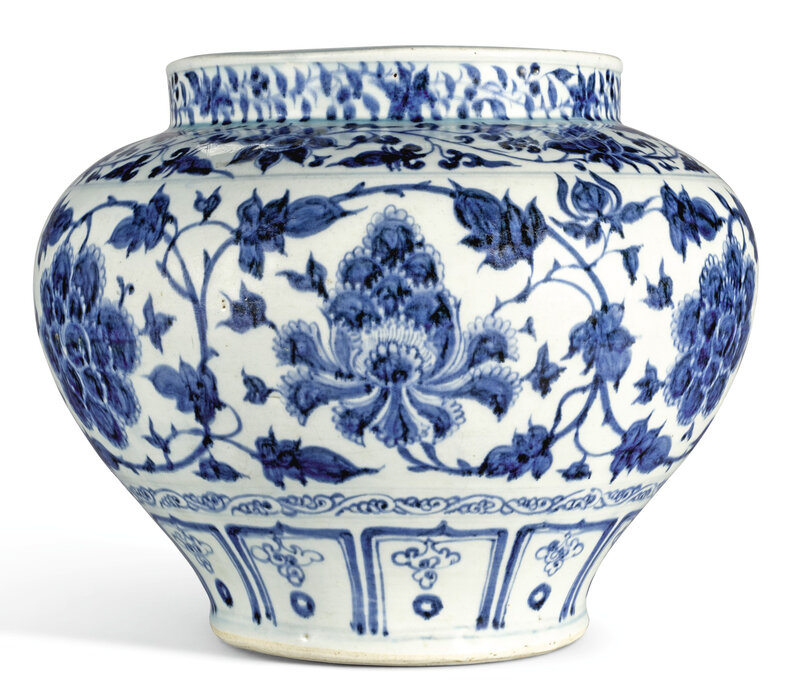A large blue and white 'peony' jar, Yuan dynasty (1279-1368)
Lot 138. A large blue and white 'peony' jar, Yuan dynasty (1279-1368). Height 27.8 cm, 10⅞ in. Estimate: 250,000 - 350,000 GBP. Unsold. Photo Sotheby's.
the broad sturdily-potted baluster body rising from a spreading foot to a short straight neck with everted rim, painted around the body in rich cobalt-blue tones with six large peony blossoms each rendered with a luxuriant array of petals, borne on the undulating scroll with attendant buds and foliage, all above a classic scroll band, the shoulder encircled with a composite floral scroll and the foot with a band of upright lappets enclosing pendent cloud-like trefoils and rings, the neck painted with a band of composite floral scroll, the broad foot ring and recessed base unglazed
Provenance L. Michiels Antiquitiés, Bruxelles (according to label).
Note: Sturdily potted guan jars painted with bold designs in cobalt blue are undoubtedly the Yuan dynasty’s greatest contribution to Chinese porcelain tradition. These jars diverge dramatically from the elegant simplicity of the Song dynasty (960-1279), which favoured subdued monochromatic wares in smaller formats, and evidence the flamboyant style preferred by the Mongol rulers of the Yuan dynasty. This change in direction accelerated the demise of most other kiln centres in China, and established the kilns at Jingdezhen as the most important centre of ceramic production for centuries to come.
The painting seen on this jar encompasses the most characteristic elements of Yuan porcelain design: the peony scroll on the body, lotus scroll on the shoulder, classic scroll on the rim and lappets. This lively new decorative vernacular was particularly well-expressed in underglaze blue. The vast trading networks of the Yuan dynasty ensured rapid transmission of styles and tastes throughout the empire. Persian traders supplied the kilns at Jingdezhen with cobalt ore from Kashan providing the vibrant blue for which the period is known. Demand for blue and white guan was considerable from its initial manufacture, not only in China but in Southeast Asian and particularly in the Middle East.
Guans of nearly identical decoration include a jar in the Idemitsu Museum of Arts, Tokyo illustrated in Chinese Ceramics in the Idemitsu Collection, Tokyo, 1987, pl. 617; an example from the Ataka collection published in Gakuji Hasebe, Masterpieces of Chinese and Korean Ceramics in the Ataka Collection. China, Tokyo, 1980, pl. 86; and a further jar in the collection of Baotou City Cultural Relics Administrative Bureau, Inner Mongolia illustrated in Zhongguo Wenwu Jinghua Daquan. Taoci Juan [Gems of China's cultural relics. Ceramics section], Hong Kong, 1993, pl. 550.
Variations on this design include a jar with a four-petal band rather than the classic scroll border illustrated in Yoshiaki Yabe, Toji Taikei. 41. Gen no Shimitsu [Compendium of Ceramics. 41. Blue and white ware of the Yuan dynasty], Tokyo, 1974, pl. 27; a jar without a scroll border in the Palace Museum, Beijing illustrated in The Complete Collection of Treasures of the Palace Museum, Blue and White Porcelain with Underglazed Red (I), Hong Kong, 2000, pl. 6; and an example with a band of waves around the collar in the Shanghai Museum included in the Museum’s exhibition, Splendors in Smalt: Art of Yuan Blue-and-white Porcelain, Shanghai, 2012, cat. no. 7.
Sotheby's. Important Chinese Art, London, 06 Nov 2019

/https%3A%2F%2Fprofilepics.canalblog.com%2Fprofilepics%2F1%2F0%2F100183.jpg)
/https%3A%2F%2Fstorage.canalblog.com%2F03%2F02%2F119589%2F96711876_o.jpg)
/https%3A%2F%2Fstorage.canalblog.com%2F11%2F31%2F119589%2F94773502_o.jpg)
/https%3A%2F%2Fstorage.canalblog.com%2F20%2F83%2F119589%2F94772815_o.jpg)
/https%3A%2F%2Fstorage.canalblog.com%2F26%2F72%2F119589%2F75604929_o.jpg)
/https%3A%2F%2Fstorage.canalblog.com%2F59%2F60%2F119589%2F26458628_o.jpg)





/image%2F1371349%2F20240414%2Fob_83ee65_2024-nyr-22642-0954-000-a-blue-and-whi.jpg)
/image%2F1371349%2F20240414%2Fob_15808c_2024-nyr-22642-0953-000-a-blue-and-whi.jpg)
/image%2F1371349%2F20240414%2Fob_e54295_2024-nyr-22642-0952-000-a-rare-blue-an.jpg)
/image%2F1371349%2F20240414%2Fob_b161a4_2024-nyr-22642-0951-000-a-blue-and-whi.jpg)